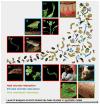Stress as a Normal Cue in the Symbiotic Environment
- PMID: 27004825
- PMCID: PMC4841697
- DOI: 10.1016/j.tim.2016.02.012
Stress as a Normal Cue in the Symbiotic Environment
Abstract
All multicellular hosts form associations with groups of microorganisms. These microbial communities can be taxonomically diverse and dynamic, and their persistence is due to robust, and sometimes coevolved, host-microbe and microbe-microbe interactions. Chemical and physical sources of stress are prominently situated in this molecular exchange, as cues for cellular responses in symbiotic microbes. Stress in the symbiotic environment may arise from three sources: host tissues, microbe-induced immune responses, or other microbes in the host environment. The responses of microbes to these stresses can be general or highly specialized, and collectively may contribute to the stability of the symbiotic system. In this review, we highlight recent work that emphasizes the role of stress as a cue in the symbiotic environment of plants and animals.
Keywords: host-microbe interactions; microbiota; stress response; symbiosis.
Copyright © 2016 Elsevier Ltd. All rights reserved.
Figures


References
-
- Sommer F, Bäckhed F. The gut microbiota: masters of host development and physiology. Nat Rev Microbiol. 2013;11:227–238. - PubMed
-
- Limpens E, et al. Lipo-chitooligosaccharides modulate plant host immunity to enable endosymbioses. Annu Rev Phytopathol. 2015:53. - PubMed
-
- Axelrod R. The evolution of cooperation. Basic Books; 1984.
Publication types
MeSH terms
Grants and funding
LinkOut - more resources
Full Text Sources
Other Literature Sources

